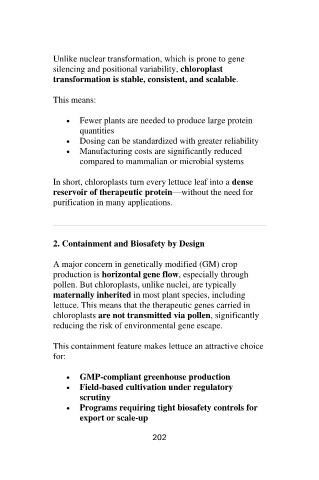Page 204 - Binder2
P. 204
Unlike nuclear transformation, which is prone to gene
silencing and positional variability, chloroplast
transformation is stable, consistent, and scalable.
This means:
• Fewer plants are needed to produce large protein
quantities
• Dosing can be standardized with greater reliability
• Manufacturing costs are significantly reduced
compared to mammalian or microbial systems
In short, chloroplasts turn every lettuce leaf into a dense
reservoir of therapeutic protein—without the need for
purification in many applications.
2. Containment and Biosafety by Design
A major concern in genetically modified (GM) crop
production is horizontal gene flow, especially through
pollen. But chloroplasts, unlike nuclei, are typically
maternally inherited in most plant species, including
lettuce. This means that the therapeutic genes carried in
chloroplasts are not transmitted via pollen, significantly
reducing the risk of environmental gene escape.
This containment feature makes lettuce an attractive choice
for:
• GMP-compliant greenhouse production
• Field-based cultivation under regulatory
scrutiny
• Programs requiring tight biosafety controls for
export or scale-up
202

